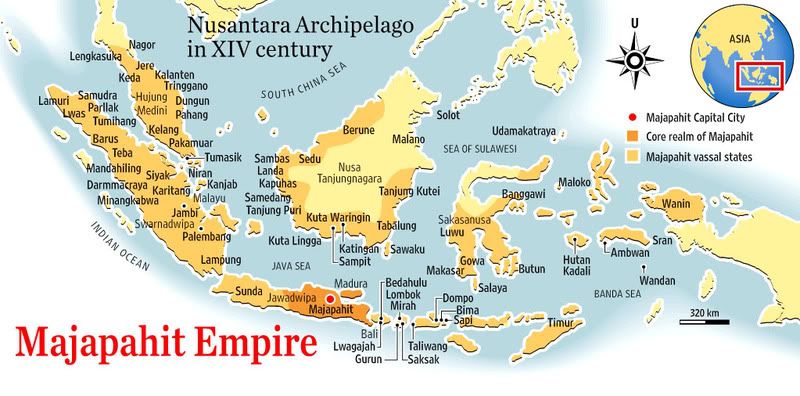After Srivijaya fell, it was largely forgotten and so historians had never considered that a large united kingdom could have been present in Southeast Asia. The existence of Srivijaya was only formally suspected in 1918 when French historian George Coedès of the École française d'Extrême-Orient postulated the existence of the empire. Around 1992 and 1993, Pierre-Yves Manguin proved that the centre of Srivijaya was along the Musi River between Bukit Seguntang and Sabokingking (situated in what is now the province of South Sumatra, Indonesia).
Golden Age of Srivijaya
In the first half of the tenth century, between the fall of Tang and the rise of Song, there was brisk trade between the overseas world and the Fujian kingdom of Min and the rich Guangdong kingdom of Nan Han. Srivijaya undoubtedly benefited from this, in anticipation of the prosperity it was to enjoy under the early Song. Circa 903, the Muslim writer Ibn Rustah was so impressed with the wealth of Srivijaya's ruler that he declared one would not hear of a king who was richer, stronger or with more revenue. The main urban centres were at Palembang (especially the Bukit Seguntang area), Muara Jambi and Kedah.
Decline Period of Srivijaya
Srivijaya's Empire and its neighbors in 900 AD.
Between 1079 and 1088, Chinese records show that Srivijaya sent ambassadors from Jambi and Palembang. In 1079 in particular, an ambassador from Jambi and Palembang each visited China. Jambi sent two more ambassadors to China in 1082 and 1088.[17] This suggests that the centre of Srivijaya frequently shifted between the two major cities during that period.[17] The Chola expedition as well as changing trade routes weakened Palembang, allowing Jambi to take the leadership of Srivijaya from the 11th century on.
According to a Chinese source in the book of Chu-fan-chi[19] written around 1178, Chou-Ju-Kua describe that in Southeast Asia archipelago there was two most powerful and richest kingdoms; Srivijaya and Java (Kediri). In Java he founds that the people adhere two kinds of religions: Buddhism and the religions of Brahmins (Hinduism), while the people of Srivijaya adhere Buddhism. The people of Java are brave and short tempered, dare to put a fight. Their favourite pastimes was cockfighting and pig fighting. The currency was made from the mixture of copper, silver, and tin.
Srivijaya Empire and Kediri around 12th to early 13th century AD.
The book of Chu-fan-chi mentioned that Java was ruled by a maharaja, that rules several colonies: Pai-hua-yuan (Pacitan), Ma-tung (Medang), Ta-pen (Tumapel), Hi-ning (Dieng), Jung-ya-lu (Hujung Galuh), Tung-ki (Jenggi, west Papua [disambiguation needed]), Ta-kang (Sumba), Huang-ma-chu (Southwest Papua), Ma-li (Bali), Kulun (Gurun, identified as Gorong or Sorong in Papua or an island in Nusa Tenggara), Tan-jung-wu-lo (Tanjungpura in Borneo), Ti-wu (Timor), Pingya-i (Banggai in Sulawesi), and Wu-nu-ku (Maluku).
About Srivijaya, Chou-Ju-Kua reported that Kien-pi (Kampe, in northern Sumatra) with armed forced rebellion has liberated themselves from Srivijaya, thus has coronated their own king. The same fate goes to some Srivijaya's colonies at Malay Peninsula that liberated themselves from Srivijaya domination. However Srivijaya still the mightiest and wealthiest state in western part of archipelago. Srivijaya's colony are: Pong-fong (Pahang), Tong-ya-nong (Trengganu), Ling-ya-ssi-kia (Langkasuka), Kilan-tan (Kelantan), Fo-lo-an , Ji-lo-t'ing (Jelutong), Ts'ien-mai , Pa-t'a (Batak), Tan-ma-ling (Tambralingga, Ligor), Kia-lo-hi (Grahi, northern part of Malay peninsula), Pa-lin-fong (Palembang), Sin-t'o (Sunda), Lan-wu-li (Lamuri at Aceh), and Si-lan (Sailan?). According to this source in early 13th century Srivijaya still ruled Sumatra, Malay peninsula, and western Java (Sunda). About Sunda, the book describe it further that the port of Sunda (Sunda Kelapa) is really good and strategic, pepper from Sunda is among the best quality. People work on agriculture and their house are build on wooden piles (rumah panggung). However the country was invested by robbers and thieves. In sum, this Chinese source from early 13th century suggested that the Indonesian archipelago was ruled by two great kingdoms, western part was under Srivijaya's rule, while eastern part was under Kediri domination.
In 1288, Singhasari, the successor of Kediri in Java, conquered Palembang, Jambi as well as much of Srivijaya during the Pamalayu expedition.
In the year 1293, Majapahit ruled much of Sumatra as the successor of Singhasari. Prince Adityawarman was given responsibilities over Sumatra in 1347 by Hayam Wuruk, the fourth king of Majapahit. The rebellion in 1377 was squashed by Majapahit but it left the area of southern Sumatra in chaos and desolation.
In the following years, sedimentation on the Musi river estuary cut the kingdom's capital off from direct sea access. The strategic disadvantage crippled the trade in the Kingdom's capital. As the decline continued, Islam made its way to the Aceh region of Sumatra, spreading through contacts with Arab and Indian traders. By the late 13th century, the kingdom of Pasai in northern Sumatra converted to Islam. At the same time, Srivijaya was briefly a tributary state of the Khmer empire and later the Sukhothai kingdom. The last inscription, on which a crown prince, Ananggavarman, son of Adityawarman, is mentioned, dates from 1374.
By 1402 Parameswara (the great-great-grandson of Raden Wijaya, the first king of Majapahit), the last prince of Srivijaya founded the Sultanate of Malacca on the Malay Peninsula.
Srivijaya's Relics

















